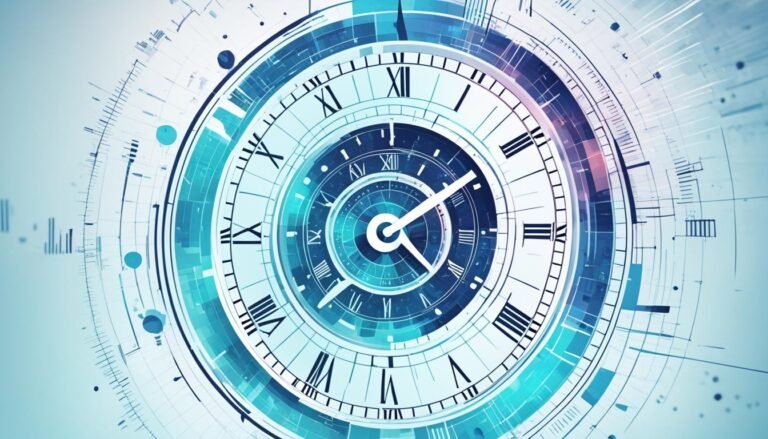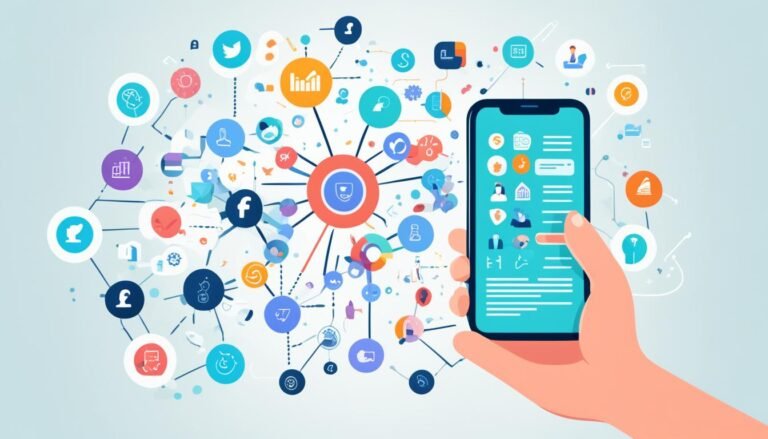How AI is Transforming Sales Forecasting for Better Accuracy
Ever thought about how businesses know what to expect in sales? They use sales forecasting to plan their budgets and set goals. But too often, this guesswork isn’t very accurate. What if we could make it better with the help of artificial intelligence (AI)?
AI, through machine learning and predictive analytics, is changing the game. It can sift through heaps of data, spot trends, and offer insights. This is a big deal in the world of sales forecasting.
Now, let’s explore how AI is shaking up sales predictions for the better.
Key Takeaways:
- AI is boosting sales forecasting accuracy by studying data and recognizing patterns.
- Machine learning and predictive analytics are key in making sales forecasts sharper.
- AI brings quick insights, suggestions tailored to your needs, and cuts down on mistakes.
- Thanks to automation and AI tools, sales forecasts are getting more accurate.
- AI makes it possible to tweak forecasts over time, making them more and more refined.
What is Sales Forecasting and Its Benefits
Sales forecasting predicts how much money a company will make in the future. It looks at past sales and trends to guess future sales. This helps in planning, setting goals, deciding budgets, and where to put resources.
Good sales forecasts help businesses make smart choices. They can adjust and improve their ways of working.
Definition of Sales Forecasting
Sales forecasting means guessing future sales using the past and looking at what’s happening now. It checks customer behavior, market trends, economic signs, and what competitors are doing. This is to see how much money a company might make next.
Importance of Sales Forecasting
Sales forecasting is vital for many reasons:
- It helps in making strong plans and goals. This is by giving companies useful information to plan their strategies and use resources wisely.
- It’s important for deciding where to put resources and how to budget well. This means companies can use their money and things they need better.
- It shows possible risks and chances in the market. This lets businesses be ready for bad things that might happen. And, it helps them take advantage of new opportunities.
- It’s key in managing risks well. Knowing what might happen in the market helps companies make choices that protect their money and keep them strong.
- Forecasting sales well means companies can see what customers want. Then, they can focus their marketing in ways that make people buy more.
- It makes a company’s work smoother and more efficient. Knowing what to expect in sales helps in making things and getting them to customers in the best way possible.
Benefits of Sales Forecasting
Forecasting sales brings big benefits for businesses:
- Strategic Planning: It sets a strong base for making the right plans and decisions. This means companies can work toward their goals effectively.
- Resource Allocation and Budgeting: Knowing sales well helps use resources better and manage how to spend money. It makes sure there’s enough of everything needed.
- Identifying Risks and Opportunities: Sales forecasts warn about risks and show chances to grow. This lets businesses stay ahead in the market.
- Risk Management: With good sales forecasts, businesses can handle risks better. This lets them make choices that protect their business and keep it safe.
- Effective Marketing Strategies: Sales forecasts highlight what customers like. This helps in making marketing that connects with people and makes them buy more.
- Enhanced Operational Efficiency: Forecasting sales well makes everything in a business run smoother. It helps in producing goods, moving them, and using resources more efficiently.
Why are Sales Forecasts Inaccurate and How AI Can Help
Sales forecasts might be off for several reasons, affecting how a business plans ahead and spends its resources. High hopes from salespeople, messy data, staff leaving, and what rivals are up to, all play a part in making forecasts wrong. Yet, AI gives us ways to make these predictions more spot on.
AI steps in to tackle these issues by handling important parts of forecasting automatically. It uses smart algorithms to check through huge amounts of data. This turns the data into useful tips for making sales. AI also helps find the best potential customers quickly.
Beyond just sorting data and spotting leads, AI can also ‘read’ how customers feel. It looks at what they’re saying to understand their worries. By doing this, it helps companies to solve problems fast. AI can also spot small shifts in trends early on, giving a heads-up for future actions.
AI makes sales predictions better by automating data work, understanding what leads are best, checking how customers feel, noticing trends, and giving predictions that help decisions.
Chatbots with AI are also a big help. They talk to customers and pick up important details. By doing this, they make the whole sales process smoother and faster. This means real people in sales can spend more time making important connections and closing deals.
Adding AI to sales predictions is a game-changer for many companies. It helps them deal with the issues behind bad forecasts. With AI working on data, leads, and understanding customer feelings, companies can predict sales more accurately. This helps them spend their money and make choices more wisely to grow their sales.
In the next part, we’ll look at the clear benefits of using AI in sales forecasting. We’ll see how it changes the game for businesses making plans and decisions.
The Benefits of AI in Sales Forecasting
AI in sales forecasting helps businesses in many ways. It makes predictions more accurate, offers insights in real-time, and enhances overall efficiency. It also tailors advice and reduces risks, all while helping businesses grow.
Improved Forecasting Accuracy with AI
AI looks at huge amounts of data and spots trends we might overlook. This leads to better forecasts than what humans can do alone. Businesses can then use these insights to make smarter decisions and cut down on forecasting mistakes.
Real-Time Insights with AI
AI gives businesses the chance to know about sales trends and how well they’re performing right now. This is done by constantly collecting and studying data. It lets companies react to changes quickly and make choices based on solid information.
Enhanced Efficiency with AI
AI takes on repetitive tasks, helping sales teams use their time better. It can handle things like entering data, scoring leads, and following up with customers. This means teams can focus on work that makes the most impact.
Personalized Recommendations with AI
AI allows companies to offer products that fit customers perfectly. It studies what customers like and suggests items just for them. This personal touch boosts sales and keeps customers happy.
Reduced Risk with AI
AI spots risks early by looking at market trends and customer actions. It helps businesses see and address potential problems before they happen. This can prevent big losses and missed chances to do well.
Scalability with AI
Forecasting models powered by AI can handle more data as businesses get bigger. They can keep up with a growing business and its increasing needs. This supports the company’s goals for the future.
In short, AI is changing how sales forecasts work. It boosts accuracy, makes operations smoother, and gives insights when they’re needed. This helps businesses stay ahead in a constantly changing market.
Data Processing and Analysis with AI in Sales Forecasting
In sales forecasting, handling data is key to making good predictions. AI algorithms are incredibly useful in this. They can sift through large sets of data, find errors, and spot important trends.
These algorithms help companies understand their sales better. They look through lots of info to find trends and give strategic advice. Businesses can use this to plan better and predict sales more accurately.
AI shines at looking into both past sales and outside factors like the market. This all-around view helps companies understand what affects their sales. With this knowledge, they can plan better and make smarter choices.
AI Algorithms for Data Processing in Sales Forecasting
AI algorithms are great at handling the many facets of sales data. They can find and fix errors, making the data trustworthy. This helps in making models for sales predictions that are on point.
They’re also good at finding hidden relationships in big data. By doing this, they can help companies predict sales more accurately. This leads to better plans on how to use resources and smarter marketing plans.
“AI algorithms can efficiently process and analyze large datasets, detecting anomalies, cleaning data, and identifying valuable insights.”
AI Insights in Sales Forecasting
A big perk of AI in sales forecasting is the insights it offers. With access to lots of data, businesses can understand market shifts and customer actions better. This knowledge turns forecasting from something that reacts to past events into something that anticipates the future.
This ability to predict the future helps businesses prepare for changes in the market. They can respond quickly and in better ways. AI insights make it possible to see new opportunities and avoid potential problems.
Another good thing is how AI helps in choosing where to invest resources. By knowing what leads to sales success, companies can spend their money wisely. This smarter use of resources can really boost business growth.
To sum up, AI changes how companies plan ahead, use their resources, and make choices. By using AI’s analytics, they can understand sales better and make predictions that are more likely to be true. This leads to better decisions and overall success.
Lead Identification and Qualification with AI in Sales Forecasting
AI is key for making lead identification and qualification better in sales forecasting. With AI tools like machine learning and predictive analytics, businesses can check out CRM data and past sales to guess which leads might buy. This AI-led system makes it easier for companies to find the best leads, up their sales game, and guess sales more accurately.
AI trudges through loads of data to notice customer habits, which helps focus sales and marketing strategies. It looks at how customers interact, what they buy, and past sales. These insights from AI help sales teams get to know their customers better and sell to them in a way that’s more likely to work.
“AI-driven lead identification and qualification help businesses optimize their sales pipeline by focusing their resources and efforts on leads with the highest potential for conversion.”
By using AI to spot and confirm leads, businesses can smooth out their sales process. This makes sure salespeople spend time on leads that look most likely to buy. It also stops spending resources on bad opportunities and helps meet sales targets better.
Plus, AI guesses if leads might turn into customers. It uses fancy math and predictive analytics to reason out which leads have a decent chance of buying. This info is gold for making plans and deciding how to use resources.
The Benefits of Lead Identification and Qualification with AI
Putting AI to work on lead finding and checking has a bunch of good points for companies:
- AI sorts leads by how likely they are to buy, letting sales focus on the most promising ones.
- It also smoothes out sales strategies based on customer behaviors and past data.
- This means finding the best leads leads to more sales and better overall performance.
- It cuts down manual work in checking leads, saving time and resources.
- Guessing leads’ conversion chances more clearly helps with better planning and decisions.
Using AI for lead spotting and checking makes sales pipelines run better and boosts sales. Businesses get to make choices based on hard data, leading to stronger sales outcomes.
Sentiment Analysis and Pattern Recognition with AI in Sales Forecasting
AI helps understand how customers feel. It looks at reviews, social media posts, and support questions. This lets companies know what their customers like or don’t like. It’s a great way to make customers happier and keep them coming back.
This technology also spots trends and patterns in how customers feel. This insight helps companies decide where to focus, what products to keep in stock, and how to change marketing.
Moreover, AI looks at lots of data to see what’s selling, what the market is doing, and how customers are interacting. It uses this to forecast sales better. Companies then know more about what to expect in their future sales.
By using AI for both understanding emotions and spotting trends, companies can become sharper. They make better forecasts, which leads to more success and a stronger position against other businesses.
Automation and AI in Sales Forecasting
AI-driven automation changes how we do sales forecasting. It makes our work smoother and more efficient. Thanks to AI technologies, businesses can use automation to make their sales predictions better. This lets sales teams look into data and trends more. They don’t have to spend as much time on dull, manual tasks.
Enhanced Sales Processes and Reduced Errors
This new way of forecasting speeds up sales. It cuts down on errors too. AI can handle things like data entry and following up with leads. This takes away the mistakes that manual work can bring. So, teams have more time and resources to use.
Saving Time and Improving Content Marketing Efforts
AI makes making content, like proposals and emails, easy and quick. Salespeople don’t have to start from zero. This means the stuff they send out is always good and right on point. It lets them really talk to customers and seal those deals.
Unleashing Sales Teams’ Analytical Potential
AI lets sales teams think more about sales data and trends. This helps them predict sales better. They can use AI to spot patterns and give them solid facts to work with. This usually leads to better sales forecasts and smarter plans.
AI-driven automation in sales forecasting makes things run better. It helps sales teams think about big data and smart choices.
Improved Sales Efficiency with AI Tools
AI tools make what we do in sales better. They help with ranking and deciding on leads. This lets salespeople use their time and resources smartly. By using AI, sales teams can get more done and work better.
Also, AI can help by giving product tips that customers will love. By looking at what customers like, AI can tell sales teams what to suggest. This makes customers happier and helps get deals done.
| Benefits of Automation and AI in Sales Forecasting |
|---|
| 1. Enhanced sales processes and reduced errors |
| 2. Time-saving and improved content marketing efforts |
| 3. Unleashing sales teams’ analytical potential |
| 4. Improved sales efficiency with AI tools |
Getting into automation and AI in sales forecasting is a big plus for any business. It makes everything work better and gets more done. In today’s world, it’s how you get ahead.
Image showing how automation and AI come together in sales forecasting.
AI for Continuous Forecasting and Iterative Improvement
AI is key in making forecasting better and improving sales estimates. It uses AI’s power to check data and adjust on the spot. This helps keep predictions sharp and up-to-date. Businesses then get a better view of upcoming sales and can plan more wisely.
Using AI, sales forecasts are not just a one-time guess. They are updated constantly with new info. This keeps the forecasts right in line with what’s happening “right now”. So, businesses can keep up with the changes and make smart moves.
Improving with AI doesn’t stop at always getting new data. It also looks back to see how it did before and gets better. This means better numbers over time. Businesses use this to be more accurate as they learn more.
Real-Time Adjustments with AI
AI makes it possible to tweak sales forecasts on the fly. It dives into huge piles of data fast to spot trends. Then, businesses can react quickly to changes. So, they are better at seeing new chances or avoiding risks.
AI-powered Sales Feedback Loop
The AI-powered sales feedback loop is at the heart of updating sales forecasts non-stop. It closes the gap between what’s happening and the predictions. So, businesses get better at always keeping their strategies up to date.
| Benefits of AI for Continuous Forecasting and Iterative Improvement |
|---|
| – Enhanced forecasting accuracy through continuous monitoring and adjustment |
| – Improved responsiveness to market changes through real-time adjustments |
| – Incremental improvements in forecasting accuracy through iterative feedback |
| – Proactive decision-making based on up-to-date insights |
| – Ability to capitalize on emerging opportunities and mitigate risks |
The Role of AI in Sales Team Optimization
AI is key in making sales teams better. It looks at how each person sells, sets up training just for them, and upgrades how they learn to sell. With AI, companies can make their sales teams stronger and get ahead in the market.
AI-powered Sales Performance Assessment
AI checks sales data to see where teams can do better. It finds what each salesperson is great at and where they can improve. This helps companies spot the best ways to boost sales by understanding their team’s skills.
AI-driven Sales Training
AI makes learning plans just for sales teams by looking at how well they sell. It finds the best lessons for each person, making them better at selling. This way, training becomes more helpful, and sales teams can do even better than before.
AI-enabled Salesperson Assignment
AI picks out who’s likely to close a deal by looking at past data and what the customer likes. It helps businesses match the perfect salesperson to each client’s needs. This makes customers happier and increases the chances of making a sale.
“AI-powered tools provide insights on effective messaging, lead assignment, and salesperson assignment, optimizing sales team performance and overall sales forecasting accuracy.”
AI for Sales Team Optimization
With AI, businesses can get more out of their sales teams. It improves by looking at how well they sell, giving them training made just for them, and choosing the right people for each sale. This makes sales teams stronger, helping businesses grow and beat their competition.
Conclusion
AI is changing how we forecast sales with more accuracy and real-time data. It helps make things more efficient, gives personalized advice, lowers risks, and grows our capacity. Now, with machine learning and predictive analytics, AI tools can look through lots of data. They find trends and give us insights for planning, allocating resources, and making choices.
Using AI lets companies forecast sales better, improve their sales teams, and make smarter choices. Adding AI to sales forecasting is a key move for better sales and results in today’s tough market.
AI can handle big data and understand market trends and customer actions. It helps predict market shifts and points out where to grow and how to boost sales efforts. By using AI, companies can lead the market, work more effectively, and reach their sales targets.







